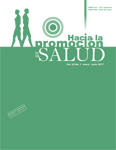Authors
Abstract
Objective: To understand the process of regulating the use of marijuana for medicinal purposes. Materials and Methods: Hermeneutical method with qualitative approach, using the interview technique, applied to fifteen experts in October 2015. Interpretation was performed from categorical system and support of Atlas.ti bar program. Results: The debate on the regulation of marijuana for therapeutic purposes continuous sweeping the globe, particularly in relation to health benefits. With the use of some cannabinoids there is some evidence, but experts consulted recognize that they are not sufficient in these cases: further investigation is recommended. The interviewed experts from different disciplines support the arguments that the ban imposed over marijuana little has achieved and that public health approaches bring a non-repressive scientific openness to the situation, placing the debate on the potential benefits it can bring for the treatment of some diseases. These regulatory processes must consider control over the production, manufacture, export, distribution, sale and use of cannabis for medical and research purposes, other than the legalization of recreational use process. Conclusion: For the Colombian case, the regulation of cannabis for medicinal purposes, until a few months ago was just an argument with radicalized positions for and against. Today it is reality as it was approved by decree on which progress in terms of legislation is being done, but with little debate, research and information to the population.
References
2. Naciones Unidas. Convención única de 1961 sobre estupefacientes. Disponible en: https://www.unodc.org/pdf/convention_1961_es.pdf
3. Valdomir S. Alguien tiene que ser primero. La iniciativa uruguaya sobre el cannabis: ¿un modelo regional? Nueva Sociedad. 2015; (255).
4. Aggarwal SK, Carter GT, Sullivan MD, ZumBrunnen C, Morrill R, Mayer JD. Medicinal use of cannabis in the United States: Historical perspectives, current trends, and future directions. Opioid Manag. 2009.
5. Insulza JM. El problema de las drogas en las Américas. (OEA Doc Of). 2013.
6. Leary WE. Marijuana, aspectos sociales, jurídicos y económicos de la obtención de enteógenos cannabinoides y alternativas a la actual política criminal, Alicante: Lex puniendi. 2012.
7. Galán JM. Proyecto de ley No 27. Bogotá: Gaceta del Congreso de Colombia. 2014.
8. Congreso de la República de Colombia. Acto legislativo 02 de 2009, Bogotá: Gaceta del Congreso. 2009.
9. Parra A. Ley 1566 del 2012. El consumo de sustancias psicoactivas, un asunto de salud pública. Bogotá: Ministerio de Salud. 2013.
10. Mascott M. Cuadros analíticos de propuestas legislativas: Cuadros analíticos sobre la regulación legal de la marihuana en diversos países del mundo. 2016; (11): 1-47.
11. Ministerio de Salud y Protección Social. Decreto 2467 de 22 de diciembre de 2015. Bogotá: Presidencia de la República. 2015.
12. Strauss A, Corbin J. Basics of qualitative research: Grounded theory procedures and techniques. Newbury. 2008.
13. Oficina de las Naciones Unidas contra la Droga y el Delito. Estrategias de orientación a jóvenes con consumos iniciales de drogas. Bogotá: UNODC. 2013.
14. Kogan NM, Mechoulam R. Cannabinoids in health and disease. Dialogues in Clinical Neuroscience. 2007.
15. Venegas S. Legalización de la marihuana, la libertad que amenaza la salud pública. Revista Chilena de Pediatría. 85(6), 653-57. [Enero 2015] Disponible en: http://www.scielo.cl/scielo.php?script=sci_arttext&pid=S0370-41062014000600001&lng=es&tlng=es.
16. Quiroga M. Cannabis: Efectos nocivos sobre la salud mental. Adicciones. 2000; 12.
17. Martine BA. Cannabinoids in medicine: A review of their therapeutic potential. Journal of Ethnopharmacology. 2006; (105): 1-25.
18. Beaulieu P. Cannabinoids for pain treatment: more clinical trials needed. Br Med J. [Enero 2015]. Disponible en: http://www.scielo.org.ar/pdf/medba/v63n6/v63n6a13.pdf.
19. NIDA Drugfacts: ¿La marihuana es un medicamento? (2013). [Enero 2015] Disponible en: http://www.drugabuse.gov/es/publicaciones/drugfacts/la-marihuana-es-un-medicamento.
20. Roncoroni AJ. Uso médico de la marihuana y cannabinoides sintéticos. Medicina. 2003; 63: 748-52.
21. Roca AJ. Cannabis medicinal. Revista Medicina. 2014; (36), 293-297.
22. Pérez GC, Velásquez E, Peláez A.O. Aportes al debate de legalización del uso medicinal de la marihuana en Colombia. Facultad Nacional de Salud Pública. 2016; 35(1).
23. Venegas V. Legalización de la marihuana, la libertad que amenaza la salud pública. Revista Chilena de Pediatría. 2014; 85 (6): 653- 657.
24. Volkow ND, Baler RD, Compton WM, Weiss SRB. Adverse Health Effects of Marijuana Use. N Engl J Med. 2014; 370, 2219-2227.
25. Elsohly MA, Slade D. Chemical constituents of marijuana: the complex mixture of natural cannabinoids. Life Sci. 2005; 78 (5):539-48.


 PDF (Español)
PDF (Español)
 FLIP
FLIP


























